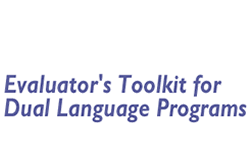Section 1: Why Evaluate?
In this section:
Accountability
DO DUAL LANGUAGE PROGRAMS WORK? That is, do students in dual language programs develop appropriate bilingual and academic competencies?
If you answered "YES" to this question, how do you know these programs work? This is a common question asked by parents, principals, teachers, superintendents, school board members, legislators, community members and journalists. Few educators and parents are willing to support a program based on a hunch that it might work. They want proof—data—that the program is successful.
Thus, one major reason for evaluation is accountability. This issue tends to permeate discussions at the local, state and national levels in the current era of rigorous standards and escalating pressure to demonstrate the academic competencies of students. Added to the dialogue on school accountability is a political climate that is unreceptive to bilingual education in some parts of the country. In this politically charged climate, we must be able to demonstrate that dual language programs work—and that they work for all student participants: English language learners (ELLs), native English speakers, students of different ethnic and socio-economic backgrounds, and special needs students.
In addition, the No Child Left Behind Act (NCLB) requires the establishment of measurable objectives for all students, including ELLs, and enforces accountability requirements. The rationale for including ELLs in high-stakes tests is to hold them to the same high standards as their peers and to ensure that their needs are not overlooked. The NCLB accountability system requires that schools assess all students (with certain exceptions) at most grade levels, but it does not charge schools with collecting data that is relevant to dual language programs, such as the progress of English language learners and native English speakers in:- oral proficiency in the non-English language,
- language arts (reading and writing) in the non-English language,
- academic achievement in challenging subject matter demonstrated through a non-English language,
- cultural, social, or affective arenas.
Describe, Monitor, and Document Your Program
There are other important reasons for doing an evaluation as well. According to Diane August & Kenji Hakuta (1998), assessment should be incorporated into the educational process so that the progress of students, teachers, programs, classrooms, and schools can be monitored. Research on effective schools also demonstrates that schools that are considered highly effective use ongoing diagnosis, evaluation and feedback. So, a well-designed evaluation can provide information to guide decisions at the school and classroom levels by:
- School level:
- Assuring that the program is meeting its goals
- Using evaluative information to further enhance the program
- Ensuring that teachers understand the model and are implementing it correctly
- Understanding teacher attitudes toward the program and students being served
- Better understanding needs of parents
- Classroom level:
- Monitoring student progress
- Providing diagnostic information about student abilities
- Guiding and improving instructional planning and activities for students
- Facilitating classroom management
- Helping students to regulate their own learning
- Communicating student performance to parents
Clearly, there are many issues that can be included in an evaluation. Developing appropriate program evaluation requires careful planning. In the next section, we will turn to the topic of making appropriate decisions about what to include in an evaluation plan.
Some of this planning requires determining what resources are available to you as you plan for your evaluation, so we turn to that next.
Resource Issues
Different types of resources will be needed to conduct a good program evaluation. These include:

- Personnel to establish the evaluation plan
- Personnel to oversee the data collection and make sure that the instruments are available at the time that they are needed, and that the data are collected on time
- Personnel to enter the data into the spreadsheet
- Personnel to conduct the analyses and interpret the results
- Funding for these personnel
- Funding for the cost of ordering and scoring tests that are not covered by the district
- Funding to make copies of questionnaires or other instruments
- Funding for professional development
These factors need to be contemplated during the course of establishing the evaluation plan, as it may be necessary to obtain additional funding from the district or fundraising or a nearby business, or to seek help from parents, or from faculty or students at a nearby university.
But, a high quality evaluation will definitely be worth its cost!
Before we move on to the next section, it is important to start a Program Evaluation Notebook (you can make the title something more interesting to you—whatever you want). This notebook will be further developed here as you begin the step-by-step procedure in evaluating your program.
SUGGESTIONS & EXAMPLES: Begin an Evaluation Notebook
![]() If you don't have a written program guide, it is difficult to evaluate your program, and now would be a good time to start to develop one or to enhance the one that you do have.
If you don't have a written program guide, it is difficult to evaluate your program, and now would be a good time to start to develop one or to enhance the one that you do have.
You should get an empty binder with dividers, and begin to fill it with information obtained in this Toolkit.
- View/download a template for your program description in PDF or Word
- View/download an example of a program description in PDF or Word

